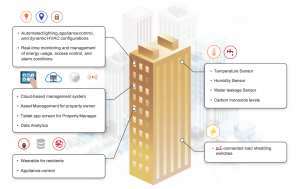What are the most common use cases for IoT and sensors in property management?
The most common use cases for Internet of Things (IoT) and sensors within property management monitor both the physical building, as well as the activity within. This includes monitoring utility usage, obtaining real-time data on building operations, and mitigating potentially dangerous and costly equipment malfunctions.
Here are some of the primary uses and advantages.
Monitoring and Reducing Utility Usage
Multifamily dwellings consume a great deal of energy. Proper utility management can contribute significantly to a property manager’s bottom line. In addition, the public expects businesses to continue to find ways to improve sustainability and prioritize environmental stewardship.
IoT technology and sensors can help property managers accomplish those goals. New heating, ventilating, and air conditioning (HVAC) and associated sensors can help property managers monitor their buildings around the clock. This data helps managers make better decisions about where energy is used. Further, managers are able to spot potential leaks and equipment breakdowns more quickly. Remote meter monitoring can provide transparency into individual tenant’s utility usage as well.
Collecting Real-Time Data
By setting acceptable parameters on sensor equipment, property managers can receive alerts or even program automatic shut-offs as soon as a piece of equipment functions outside a particular range. In this way, property managers may be able to issue a preventive maintenance work order instead of responding to an emergency repair situation. Critical equipment and assets stay online without interruption, improving tenant satisfaction.
Mitigating Dangerous, Expensive Situations
Water damage is one of the most common and costly experiences for property managers and the number one insurance claim filed. By employing IoT technology, water-level sensors and automatic shut-off valves, property managers can save thousands of dollars in water damage as well as keep facilities up and running for tenants.
Although water level sensors may be one of the most important IoT technologies to implement, many other sensors that monitor electrical performance, temperature, and vibration are also available.

Want to keep reading?
Pressure Sensors: Types, Use Cases, and Definition
What’s The Difference Between Sensors and Actuators?
What is Property Maintenance? | A Beginner's Guide
4,000+ COMPANIES RELY ON ASSET OPERATIONS MANAGEMENT
Leading the Way to a Better Future for Maintenance and Reliability
Your asset and equipment data doesn't belong in a silo. UpKeep makes it simple to see where everything stands, all in one place. That means less guesswork and more time to focus on what matters.


![[Review Badge] GetApp CMMS 2022 (Dark)](https://www.datocms-assets.com/38028/1673900459-get-app-logo-dark.png?auto=compress&fm=webp&w=347)
![[Review Badge] Gartner Peer Insights (Dark)](https://www.datocms-assets.com/38028/1673900494-gartner-logo-dark.png?auto=compress&fm=webp&w=336)
